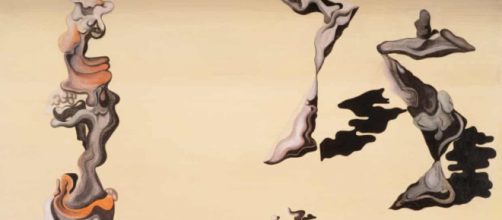The surprising start of early 20th-century Surrealist Yves Tanguy is no less surprising than the recent news about him. (More about his start in a moment).
First the news
"Fraud in the Garden," painted by Tanguy in 1930, was slashed that same year by Fascist groups as it was displayed in the lobby of a Paris movie theater screening Luis Bunuel’s satiric “L’Age d’Oro.”
The painting is vintage Tanguy describing a desolate desert-landscapes with amoebic-shaped beings with metallic skins – a clear departure from the real world but a mockery of it at the same time.
The knifing of the painting ruined it and until now was thought lost to history. But the damaged work was picked up at an auction by a Frenchman who had it restored good as new.
The repairs are so good that the art world thought it is a fake. But X-rays of the underpainting show the original slash marks.
As unexpected as this news is Tanguy's start as a Surrealist was equally surprising. He never intended to be a painter. His artmaking story began by accident on a bus ride in Paris.
Gazing out the bus window at the passing streets, an image caught his eye – a painting in an art gallery window by Surrealist Giorgio de Chirico. Tanguy reportedly stopped the bus, headed straight for the window, and stood staring at the picture in the window for hours.
Mocking modern life
Tanguy is said to have immediately started painting in the manner of a Surrealist, even though he had no art training. To rid his mind of real-world imagery, he rendered all his picture parts upside down, making the end result nearly unfathomable.
While his start in the art world was unusual, he is not the only self-taught painter who achieved fame for his work. Henri Rousseau comes to mind. He started painting when he was 40.
According to historians Donald Hall and Pat Corrington Whykes, Rousseau, a clerk by trade, knew so little about art that when told his work was as beautiful as Giotto’s, he asked, “Who is Giotto?”
Like Giotto, famed for accurate drawing from life, Rousseau rendered clearly every leaf in his many jungle pictures.
But he also enlarged each leaf to look menacing and to evoke people’s fear of the unknown.
Informal education
Rousseau’s pictures became as famous as those of Van Gogh, who also was self-taught. Home-schooled by his mother, he became a failed missionary for impoverished minders in Belgium and began painting only after being prodded by his brother Theo who saw his sketches of the miners.
Van Gogh, though celebrated for his paintings, was a mighty writer that too often goes unheralded. You can see it in his letters to his brother about loneliness:
“There may be a great fire in our soul, yet no one ever comes to warm himself at it, and the passersby see only a wisp of smoke coming through the chimney and go along their way.” Not bad for the homeschooled boy.
With bios like those of Tanguy, Rousseau, and Van Gogh, the value of formal education comes into question.


